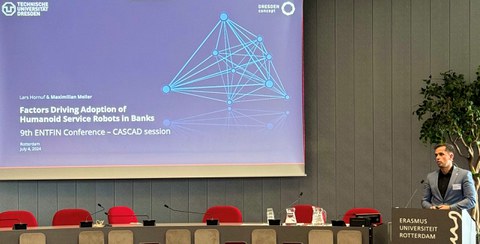Jul 07, 2025
Presentation at the 9th ENTFIN conference - CASCAD session
On July 4, Maximilian Meiler presented a recent working paper on „Factors Driving the Adoption of Humanoid Service Robots in Banks”, joint work with Lars Hornuf, at the the CASCAD session during the 9th ENTFIN conference in Rotterdam, the Netherlands. The paper received the CASCAD reproducibility certification, which warrants that the numerical results, including tables and figures reported in a scientific publication are reproducible using an identifiable set of numerical resources, such as code and data, made available by the authors of this publication. This certification involves a rigorous evaluation process conducted by a reviewer under the supervision of an editor.
In the paper, Maximilian Meiler and Lars Hornuf examine the factors driving the adoption of humanoid service robots in Austrian, German, and Swiss banks. We integrate the technology acceptance model and the technology-organization-environment framework, and employ structural equation modeling to analyze data from the top management of 106 banks. Despite humanoid service robots’ potential to shape the service industry’s future, their adoption rate in banks remains low. Barriers to adoption include limited organizational readiness, technical limitations, and regulatory concerns, which are particularly relevant for smaller banks with limited resources. Nevertheless, many banks express a strong intention to adopt humanoid service robots. We find that the relative advantage of the innovation, top management support, competitive pressure, and customer acceptance drive the perceived usefulness of humanoid service robots. Moreover, customer acceptance significantly enhances perceived ease of use by the bank. Together, perceived usefulness and perceived ease of use significantly increase banks’ intention to adopt humanoid service robots. However, due to existing adoption barriers, some banks perceive humanoid service robots as fascinating novelties rather than essential operational tools. As a result, banks are exploring alternatives such as digital avatars and bots for certain tasks while continuing to prioritize human-to-human interactions in non-online customer services.
You can access the working paper here: https://papers.ssrn.com/sol3/papers.cfm?abstract_id=4957613

